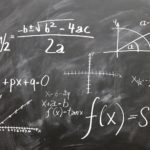Syllabus

This page is a reference to the Cambridge IGCSE Mathematics 0444 syllabus. Each syllabus item is linked (or will be) to a page that will have a Teacher Guide, Lesson Guide, Assignment, Textbook Material for students, and other references.
For a reference on sequence and time constraints, please visit The Hub.
If the column marked E has an x in it, that item is for the extended curriculum only.
Start Here
If you'd like a downloadable copy of the syllabus reference document, you can download one here. This way you can have it one your desktop and use it as a reference whenever you like. Keep in mind this document is under construction. As I go through and upload more content I will reference it here and on The Hub.
The numbers at the top are the content numbers as structured by Cambridge International. The first, #1, is Number. #2 is Algebra. #3 is Functions. #4 is Geometry, and #5 is Transformations and Vectors. #6 is Geometrical Measurement and #7 is Coordinate Geometry. #8 is Trigonometry, #9 is Probability and #10 is Statistics.
Number | E | Description | Link |
| Unit 1 Number | |||
| 1.1 |
|
Knowledge of: natural numbers, integers (positive, negative, and zero), prime numbers, square numbers, rational and irrational numbers, real numbers. Use of symbols: =, ≠, <, >
|
Inequalities |
| 1.2 |
|
Use of the four operations and parentheses.
| |
| 1.3 |
|
Multiples and factors, including greatest common factor, least common multiple.
| |
| 1.4 |
|
Ratio and proportion.
|
|
| 1.5 |
|
Understand and use the language and notation of fractions, decimals, and percentages; recognize equivalences between decimals, fractions, ratios, and percentages and convert between them. Order quantities given in different forms by magnitude, by first converting into same form.
|
|
| 1.6 |
|
Percentages, including applications such as interest and profit.
|
|
| 1.7 |
|
Meaning and calculation of exponents (powers, indices) including positive, negative, zero, and fractional exponents. Explain the definition of radical exponents as an extension to integral exponents. Explain the rules for exponents. Scientific notation (Standard Form)
|
|
| 1.8 |
|
Radicals, calculation and simplification of square root and cube root expressions.
| |
| 1.9 |
|
Use units to understand problems and guide the solution to multi-step problems. Quantities—choose and interpret units and scales, define appropriate quantities (including money). Estimating, rounding, decimal places, and significant figures—choose a level of accuracy appropriate for a problem.
|
|
| 1.10 |
|
Calculations involving time: seconds (s), minutes (min), hours (h), days, months, years including the relation between consecutive units.
|
|
| 1.11 |
|
Speed, distance, time problems.
|
|
Number | E | Description | Link |
Unit 2Algebra | |||
| 2.1 | x |
Writing, showing, and interpretation of inequalities on the real number line.
|
|
| 2.2 | x |
Create and solve linear inequalities.
|
|
| 2.3 |
|
Create expressions and create and solve linear equations, including those with fractional expressions.
|
|
| 2.4 |
|
Exponents (indices).
|
|
| 2.5 |
|
Rearrangement and evaluation of formulae.
|
|
| 2.6 |
|
Create and solve systems of linear equations in two variables algebraically and graphically.
|
|
| 2.7 |
|
Identify terms, factors, and coefficients. Interpret algebraic expressions in terms of a context.
|
|
| 2.8 |
|
Expansion of parentheses, including the square of a binomial. Simplify expressions.
|
|
| 2.9 |
|
Use equivalent forms of an expression or function to reveal and explain properties of the quantities or function represented. Factorization: common factor difference of squares trinomial four term.
|
|
| 2.10 | x |
Algebraic fractions: simplification, including use of factorization addition or subtraction of fractions with linear denominators multiplication or division and simplification of two fractions.
| |
| 2.11 | x |
Create and solve quadratic equations by: inspection factorization using the quadratic formula completing the square.
|
|
| 2.12 | x |
Solve simple rational and radical equations in one variable and discount any extraneous solutions.
|
|
| 2.13 |
|
Continuation of a sequence of numbers or patterns; recognize patterns in sequences; generalize to simple algebraic statements, including determination of the nth term. Derive the formula for the sum of a finite geometric series, and use the formula to solve problems.
|
|
| 2.14 | x |
Express direct and inverse variation in algebraic terms and use this form of expression to find unknown quantities.
|
|
Number | E | Description | Link |
Unit 3Functions | |||
| 3.1 |
|
Use function notation. Knowledge of domain and range. Mapping diagrams.
|
|
| 3.2 |
|
Understand and explain that the graph of an equation in two variables is the set of all its solutions plotted in the co-ordinate plane. Construct tables of values and construct graphs of functions of the form axn where a is a rational constant and n = –2, –1, 0, 1, 2, 3 and simple sums of not more than three of these and for functions of the type ax where a is a positive integer. Solve associated equations approximately by graphical methods.
|
|
| 3.3 |
|
Write a function that describes a relationship between two quantities.
|
|
| 3.4 | x |
Compare properties of two functions each represented in a different way (algebraically, graphically, numerically in tables, or by verbal descriptions).
|
|
| 3.5 |
|
Recognition of the following function types from the shape of their graphs: linear f(x) = ax + b quadratic f(x) = ax2 + bx + c cubic f(x) = ax3 + bx2 + cx + d reciprocal f(x)= x a exponential f(x) = ax with 0 < a < 1 or a > 1 trigonometric f(x) = asin(bx); acos(bx); tanx Interpret the key features of the graphs—to include intercepts; intervals where the function is increasing, decreasing, positive, negative; relative maxima and minima; symmetries; end behavior and periodicity.
|
|
| 3.6 |
|
Relate the domain of a function to its graph and, where applicable, to the quantitative relationship it describes.
|
|
| 3.7 | x |
Calculate and interpret the average rate of change of a function (presented symbolically or as a table) over a specified interval. Estimate the rate of change from a graph.
|
|
| 3.8 | x |
Behavior of linear, quadratic, and exponential functions: linear f(x) = ax + b quadratic f(x) = ax2 + bx + c exponential f(x) = ax with 0 < a < 1 or a > 1
|
|
| 3.9 | x |
Construct linear and exponential functions, including arithmetic and geometric sequences, given a graph, a description of a relationship, or two input-output pairs (include reading these from a table).
|
|
| 3.10 | x |
Simplification of formulae for composite functions such as f(g(x)) where g(x) is a linear expression.
|
|
| 3.11 | x |
Inverse function f –1.
|
|
| 3.12 |
|
Description and identification, using the language of transformations, of the changes to the graph of y = f(x) when y = f(x) + k, y = k f(x), y = f(x + k) for f(x) given in section 3.5.
|
|
| 3.13 | x |
Graph the solutions to a linear inequality in two variables as a half-plane (region), excluding the boundary in the case of a strict inequality. Graph the solution set to a system of linear inequalities in two variables as the intersection of the corresponding half-planes.
|
|
Number | E | Description | Link |
Unit 4Geometry | |||
| 4.1 |
|
Vocabulary: Know precise definitions of acute, obtuse, right angle, reflex, equilateral, isosceles, congruent, similar, regular, pentagon, hexagon, octagon, rectangle, square, kite, rhombus, parallelogram, trapezoid, and simple solid figures.
| |
| 4.2 |
|
Definitions: Know precise definitions of angle, circle, perpendicular line, parallel line, and line segment, based on the undefined notions of point, line, distance along a line, and distance around a circular arc.
| |
| 4.3 |
|
Line and rotational symmetry in 2D.
| |
| 4.4 |
|
Angles around a point. Angles on a straight line and intersecting straight lines. Vertically opposite angles. Alternate and corresponding angles on parallel lines. Angle properties of triangles, quadrilaterals, and polygons. Interior and exterior angles of a polygon.
| |
| 4.5 |
|
Construction. Make formal geometric constructions with compass and straight edge only. Copy a segment; copy an angle; bisect a segment; bisect an angle; construct perpendicular lines, including the perpendicular bisector of a line segment. Construct an equilateral triangle, a square, and a regular hexagon inscribed in a circle. Construct the inscribed and circumscribed circles of a triangle. Construct a tangent line from a point outside a given circle to the circle. Angle measurement in degrees. Read and make scale drawings.
| |
| 4.6 |
|
Vocabulary of circles. Properties of circles: • tangent perpendicular to radius at the point of contact • tangents from a point • angle in a semicircle • angles at the center and at the circumference on the same arc • cyclic quadrilateral Use the following symmetry properties of a circle: • equal chords are equidistant from the center • the perpendicular bisector of a chord passes through the center • tangents from an external point are equal in length.
| |
| 4.7 |
|
Similarity. Calculation of lengths of similar figures.
| |
| 4.8 | x |
Congruence. Recognize that two shapes are congruent and use this to solve problems.
| |
Number | E | Description | Link |
Unit 5Transformations and Vectors | |||
| 5.1 |
|
Vector notation: a; directed line segment AB ; component form use appropriate symbols for vectors and their magnitudes.
|
|
| 5.2 | x |
Find the components of a vector by subtracting the co-ordinates of an initial point from the co-ordinates of a terminal point. Use position vectors.
|
|
| 5.3 | x |
Calculate the magnitude of a vector.
|
|
| 5.4 | x |
Add and subtract vectors.
|
|
| 5.5 | x |
Multiply a vector by a scalar.
|
|
| 5.6 |
|
Transformations on the cartesian plane: translation, reflection, rotation, enlargement (dilation), stretch. Description of a translation using column vectors.
|
|
| 5.7 | x |
Inverse of a transformation.
|
|
| 5.8 | x |
Combined transformations.
|
|
Number | E | Description | Link |
Unit 6Geometrical Measurement | |||
| 6.1 |
|
Units: mm, cm, m, km mm2 , cm2 , m2 , ha, km2 mm3 , cm3 , ml, cl, l, m3 g, kg.
|
|
| 6.2 |
|
Perimeter and area of rectangle, triangle, and compound shapes derived from these. Area of trapezoid and parallelogram.
| |
| 6.3 |
|
Circumference and area of a circle. Arc length and area of sector.
| |
| 6.4 |
|
Surface area and volume of a prism and a pyramid (in particular, cuboid, cylinder, and cone). Surface area and volume of a sphere.
| |
| 6.5 | x |
Areas and volumes of compound shapes.
|
|
| 6.6 |
|
Use geometric shapes, their measures, and their properties to describe objects.
| |
| 6.7 | x |
Identify the shapes of two-dimensional cross sections of three-dimensional objects, and identify three-dimensional objects generated by rotations of two-dimensional objects.
| |
| 6.8 | x |
Apply concepts of density based on area and volume in modeling situations.
|
|
| 6.9 | x |
Apply geometric methods to solve design problems.
|
|
Number | E | Description | Link |
Unit 7Coordinate Geometry | |||
| 7.1 |
|
Plotting of points and reading from a graph in the cartesian plane.
|
|
| 7.2 |
|
Distance between two points.
|
|
| 7.3 |
|
Midpoint of a line segment. Find the point on a directed line segment between two given points that partitions the segment in a given ratio.
|
|
| 7.4 |
|
Slope of a line segment.
|
|
| 7.5 |
|
Interpret and obtain the equation of a straight line as y = mx + b. Interpret and obtain the equation of a straight line as ax + by = d (a, b, and d are integers).
|
|
| 7.6 |
|
Slope of parallel line. Find the equation of a line parallel to a given line that passes through a given point. Slope of perpendicular line. Find the equation of a line perpendicular to a given line that passes through a given point.
|
|
Number | E | Description | Link |
Unit 8Trigonometry | |||
| 8.1 |
|
Use trigonometric ratios and the Pythagorean Theorem to solve right-angled triangles in applied problems. Know the exact values for the trigonometric ratios of 0°, 30°, 45°, 60°, 90°.
|
|
| 8.2 | x |
Extend sine and cosine values to angles between 0° and 360°. Explain and use the relationship between the sine and cosine of complementary angles. Graph and know the properties of trigonometric functions.
|
|
| 8.3 | x |
Sine Rule (Law of Sines).
|
|
| 8.4 | x |
Cosine Rule (Law of Cosines).
|
|
| 8.5 | x |
Area of triangle.
|
|
Number | E | Description | Link |
Unit 9Probability | |||
| 9.1 |
|
Probability P(A) as a fraction, decimal, or percentage. Significance of its value, including using probabilities to make fair decisions.
|
|
| 9.2 |
|
Relative frequency as an estimate of probability.
|
|
| 9.3 |
|
Expected number of occurrences.
|
|
| 9.4 | x |
Combining events: Apply the addition rule P(A or B) = P(A) + P(B) – P(A and B) Apply the multiplication rule P(A and B) = P(A) × P(B).
|
|
| 9.5 |
|
Possibility diagrams. Tree diagrams including successive selection with or without replacement.
|
|
Number | E | Description | Link |
Unit 10Statistics | |||
| 10.1 |
|
Reading and interpretation of graphs or tables of data.
|
|
| 10.2 |
|
Discrete and continuous data.
|
|
| 10.3 |
|
Compound bar chart, dot plots, line graph, pie chart, simple frequency distributions, scatter diagram.
|
|
| 10.4 | x |
Mean, mode, median, and range from lists of discrete data. Mean, modal class, median, and range from grouped and continuous data.
|
|
| 10.5 | x |
Histograms with frequency density on the vertical axis.
|
|
| 10.6 | x |
Cumulative frequency table and curve and box plots. Median, quartiles, percentiles, and inter-quartile range.
|
|
| 10.7 | x |
Use and interpret statistics appropriate to the shape of the data distribution to compare center (median, mean) and spread (inter-quartile range) of two or more different data sets.
|
|
| 10.8 |
|
Understanding and description of correlation (positive, negative, or zero) with reference to a scatter diagram. Straight line of best fit (by eye) through the mean on a scatter diagram.
|
|



